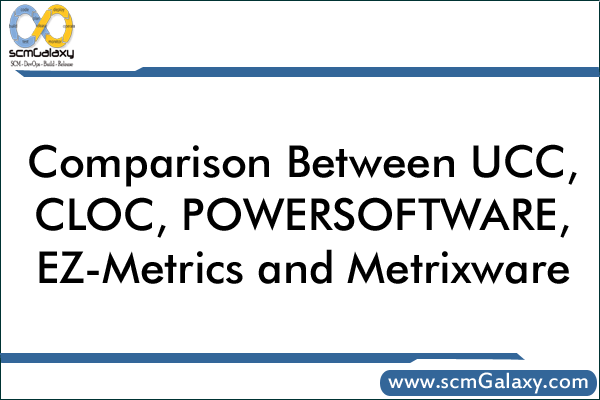USC CodeCount and USC COCOMO- $0
CodeCount automates the collection of source code sizing information. The CodeCount toolset utilizes one of two possible source lines of code (SLOC) definitions, physical or logical. COCOMO (COnstructive COst MOdel), is a tool which allows one to estimate the cost, effort, and schedule associated with a prospective software development project.
Languages: Ada, Assembly, C, C++, COBOL, FORTRAN, Java, JOVIAL, Pascal, PL1
SLOCCount – $0
SLOCCount is a set of tools for counting physical Source Lines of Code (SLOC) in a large number of languages of a potentially large set of programs. SLOCCount can automatically identify and measure many programming languages.
Languages: Ada, Assembly, awk, Bourne shell and variants, C, C++, C shell, COBOL, C#, Expect, Fortran, Haskell, Java, lex/flex, LISP/Scheme, Makefile, Modula-3, Objective-C, Pascal, Perl, PHP, Python, Ruby, sed, SQL, TCL, and Yacc/Bison.
SourceMonitor – $0
SourceMonitor lets you see inside your software source code to find out how much code you have and to identify the relative complexity of your modules. For example, you can use SourceMonitor to identify the code that is most likely to contain defects and thus warrants formal review. Collects metrics in a fast, single pass through source files. Displays and prints metrics in tables and charts.
Languages: C++, C, C#, Java, Delphi, Visual Basic (VB6) or HTML
LOCC – $0
LOCC is an extensible system for producing hierarchical, incremental measurements of work product size that are useful for estimation, planning, and other software engineering activities. LOCC supports size measurement of grammar-based languages through integrated support for JavaCC. LOCC produces size data corresponding to the number of packages, the number of classes in each package, the number of methods in each class, and the number of lines of code in each method.
Languages: C++, Java
Code Counter Pro – $25
Code Counter Pro is perfect for those reports you need to send to your boss – count up all your progamming lines (SLOC, KLOC) automatically, find out your team’s productivity, use as handy help for measuring Function Points through Backfiring, measure comment percentages and more.
Languages: ASM, COBOL, C, C++, C#, Fortran, Java, JSP, PHP, HTML, Delphi, Pascal, VB, XML
SLOC Metrics – $99
SLOC Metrics measures the size of your source code based on the Physical Source Lines of Code metric recommended by the Software Engineering Institute at Carnegie Mellon University (CMU/SEI-92-TR-019). Specifically, the source lines that are included in the count are the lines that contain executable statements, declarations, and/or compiler directives. Comments, and blank lines are excluded from the count. When a line or statement contains more than one type, it is classified as the type with the highest precedence. The order of precedence for the types is: executable, declaration, compiler directive, comment and lastly, white space.
Languages: ASP, C, C++, C#, Java, HTML, Perl, Visual Basic
Resource Standard Metrics – $200
Resource Standard Metrics, or RSM, is a source code metrics and quality analysis tool unlike any other on the market. The unique ability of RSM to support virtually any operating system provides your enterprise with the ability to standardize the measurement of source code quality and metrics throughout your organization. RSM provides the fastest, most flexible and easy-to-use tool to assist in the measurement of code quality and metrics.
Languages: C, C++, C#, Java
EZ-Metrix – $495
EZ-Metrix supports software development estimates, productivity measurement, schedule forecasting and quality analysis. With an easy Internet-based interface, multiple language support and flexible licensing features, you will be up and running in minutes with EZ-Metrix. Measure source code size from virtually all text-based languages and from any platform or operating system with the same utility. Size data may be stored in EZ-Metrix’s internal database or may be exported for further analysis.
Languages: Ada, ALGOL, antlr, asp, Assembly, awk, bash, BASIC, bison, C, C#, C++, ColdFusion, Delphi, Forth, FORTRAN, Haskell, HTML, Java, Javascript, JOVIAL, jsp, lex, lisp, Makefile, MUMPS, Pascal, Perl, PHP, PL/SQL, PL1, PowerBuilder, ps, Python, Ruby, sdl, sed, SGML, shell, SQL, Visual Basic, XML, Yacc
McCabe IQ – $ unknown
McCabe IQ enables you to deliver better, more reliable software to your end-users, and is known worldwide as the gold standard for the analysis, comprehension, testing, and reengineering of new software and legacy systems. McCabe IQ uses advanced software metrics to identify, objectively measure, and report on the complexity and quality of your code at the application and enterprise level.
Languages: Ada, ASM86, C, C#, C++.NET, C++, COBOL, FORTRAN, Java, JSP, Perl, PL1, VB, VB.NET

Rajesh Kumar
Good Reference can be found on
<!–[if gte mso 9]> Normal 0 false false false EN-US X-NONE X-NONE MicrosoftInternetExplorer4 <![endif]–><!–[if gte mso 9]> <![endif]–><!–[if gte mso 10]> <! /* Style Definitions */ table.MsoNormalTable {mso-style-name:”Table Normal”; mso-tstyle-rowband-size:0; mso-tstyle-colband-size:0; mso-style-noshow:yes; mso-style-priority:99; mso-style-qformat:yes; mso-style-parent:””; mso-padding-alt:0in 5.4pt 0in 5.4pt; mso-para-margin:0in; mso-para-margin-bottom:.0001pt; mso-pagination:widow-orphan; font-size:11.0pt; font-family:”Calibri”,”sans-serif”; mso-ascii-font-family:Calibri; mso-ascii-theme-font:minor-latin; mso-fareast-font-family:”Times New Roman”; mso-fareast-theme-font:minor-fareast; mso-hansi-font-family:Calibri; mso-hansi-theme-font:minor-latin; mso-bidi-font-family:”Times New Roman”; mso-bidi-theme-font:minor-bidi;} –> <!–[endif]–>
<!–[if gte mso 9]> Normal 0 false false false EN-US X-NONE X-NONE MicrosoftInternetExplorer4 <![endif]–><!–[if gte mso 9]> <![endif]–><!–[if gte mso 10]> /* Style Definitions */ table.MsoNormalTable {mso-style-name:”Table Normal”; mso-tstyle-rowband-size:0; mso-tstyle-colband-size:0; mso-style-noshow:yes; mso-style-priority:99; mso-style-qformat:yes; mso-style-parent:””; mso-padding-alt:0in 5.4pt 0in 5.4pt; mso-para-margin:0in; mso-para-margin-bottom:.0001pt; mso-pagination:widow-orphan; font-size:11.0pt; font-family:”Calibri”,”sans-serif”; mso-ascii-font-family:Calibri; mso-ascii-theme-font:minor-latin; mso-fareast-font-family:”Times New Roman”; mso-fareast-theme-font:minor-fareast; mso-hansi-font-family:Calibri; mso-hansi-theme-font:minor-latin; mso-bidi-font-family:”Times New Roman”; mso-bidi-theme-font:minor-bidi;} <![endif]–>
http://community.scmgalaxy.com/pg/file/read/4281/sloc-using-rsm
http://cloc.sourceforge.net/
http://www.qsm.com/?q=resources/code-counters/index.html
http://en.wikipedia.org/wiki/Source_lines_of_code